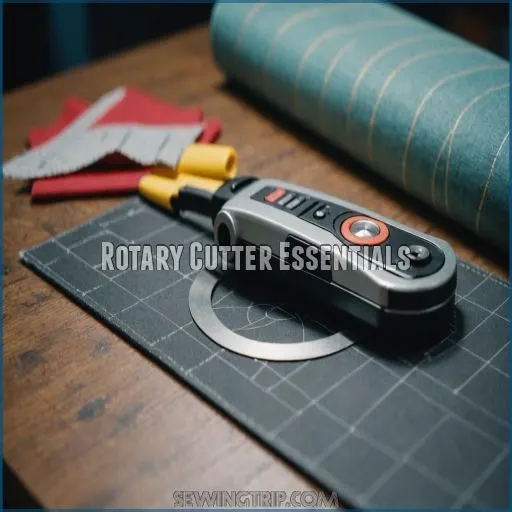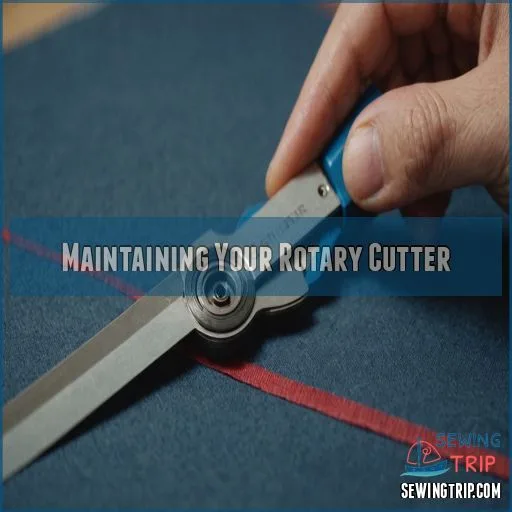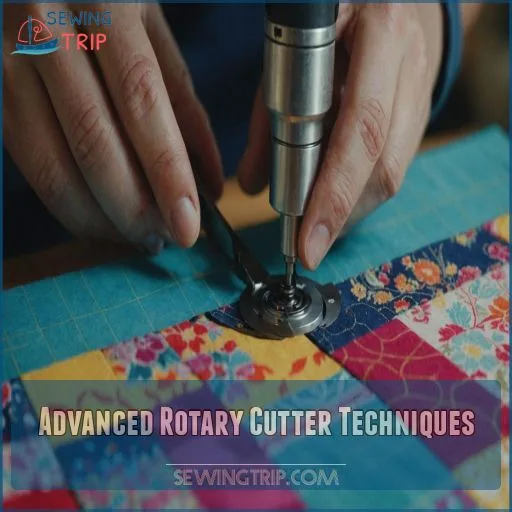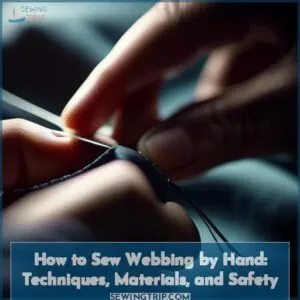This site is supported by our readers. We may earn a commission, at no cost to you, if you purchase through links.
 Choosing and using a rotary cutter seems tricky, but it’s not rocket science. Look for a comfortable handle that feels like a firm handshake—ergonomic ones keep you cutting for hours without fatigue.
Choosing and using a rotary cutter seems tricky, but it’s not rocket science. Look for a comfortable handle that feels like a firm handshake—ergonomic ones keep you cutting for hours without fatigue.
Pair your cutter with a sharp blade—like a classic straight one for precise cuts, or a pinking blade to zigzag those pesky fabric edges. Safety first, though!
Make sure you retract the blade when not cutting. Grab a self-healing mat to keep it sharp and steady.
Want neat dotted lines? Try a perforation blade. Ready for pro tips on perfecting those tricky curves and corners? Stay tuned!
Table Of Contents
- Key Takeaways
- Choosing the Right Rotary Cutter
- Rotary Cutter Essentials
- Rotary Cutter Safety Precautions
- Rotary Cutter Sizes and Applications
- Rotary Cutter Blade Types
- Mastering Rotary Cutter Techniques
- Maintaining Your Rotary Cutter
- Common Issues With Rotary Cutters
- Rotary Cutters for Specific Tasks
- Advanced Rotary Cutter Techniques
- Frequently Asked Questions (FAQs)
- Conclusion
Key Takeaways
- Find a rotary cutter that fits your hand like a firm handshake—look for ergonomic handles that reduce fatigue and give you great control when slicing through fabric.
- Pair your cutter with the right blade for the job, whether it’s a classic straight blade for precise cuts or a pinking blade to prevent fraying. And don’t forget to play it safe by always retracting the blade when not in use.
- Make your rotary cutter really shine by using it with a self-healing cutting mat and a non-slip ruler. This dynamic duo will help you achieve smooth, straight cuts every time.
- Master rotary cutter techniques, such as proper grip, stance, and cutting pressure, to tackle even the trickiest curves and corners. With a little practice, you’ll be slicing through fabric like butter.
Choosing the Right Rotary Cutter
Choosing the right rotary cutter involves considering the handle type, blade style, and safety features.
Make sure it works well with your cutting mat and non-slip ruler for the best results.
Considerations for Handle Type and Size
Choosing the right handle type impacts your cutting performance. Consider handle comfort and grip strength for blade control.
Ergonomic handles suit various hand sizes and reduce fatigue, while straight handles offer straightforward simplicity. A universal opening makes it easy to use, and a safety cage protects fingers.
Look for a handle with thumb indentations molded for a natural hold and a cushioned grip to reduce pressure points, especially during extended sewing sessions. For the best control, choose a handle with a wider diameter to distribute weight across your hand, much like those designed for rotary cutter comfort.
Match the handle to your project scale to avoid wear out.
Types of Blades Available for Rotary Cutters
Discover the array of rotary cutter blades at your fingertips!
From the classic straight blade to the versatile pinking, wave, and perforation options, each has its own unique purpose.
Whether you’re quilting, sewing, or crafting, the right blade can make all the difference.
Pair it with your trusty self-healing mat for precision cuts every time.
Additional Safety Features
It’s wise to think about safety features when picking a rotary cutter.
Make sure it has:
- Blade Guards: Protect your hands from accidental cuts.
- Safety Locks: Secure the blade during storage and travel.
- Ergonomic Grips: Reduce hand fatigue and ensure comfortable handling during long fabric cutting sessions.
These features keep your projects running smoothly and safely.
Non-Slip Ruler and Cutting Mat Compatibility
When using a rotary cutter, non-slip rulers and cutting mats are essential for safe, accurate cuts.
Look for mats with a good grip and rulers that prevent slipping. Consider your mat size and choose a ruler that aligns well.
A quality mat improves your cutter’s performance and guarantees smooth, straight cuts every time, making for smooth, straight cuts .
Rotary Cutter Essentials
To make perfect cuts, you need the right tools and techniques, starting with a self-healing cutting mat and a non-slip ruler.
Proper handling and posture will keep your cuts tidy and your fingers safe.
Importance of Self-Healing Cutting Mats
Choosing the right rotary cutter paves the way to precision, but don’t overlook the magic underneath: self-healing cutting mats.
They protect surfaces, allowing your rotary cutter to glide effortlessly over patterns.
They close up cuts quickly, enhancing mat lifespan and durability. With various sizes and thicknesses, they’re a reliable board companion, ensuring smooth, repeatable cuts and a longer mat lifespan.
Role of Non-Slip Rulers in Accurate Cutting
Non-slip rulers play a vital role in cutting accuracy. They prevent slipping, ensuring your rotary cutter follows a straight path.
When using a rotary cutter, it’s essential to maintain a neutral hand position and consider ergonomic-designed handles to reduce strain. For instance, the best rotary cutter fabric cutting experience involves choosing the right blade size, such as the 45mm blade, which offers great versatility for fabric cutting.
To achieve accurate cutting, select rulers with a non-slip coating, like Creative Grids or TrueGrips, which provide stability on your fabric. This stability enhances fabric alignment and mat alignment, making your projects easier and more precise.
Proper Handling and Posture for Rotary Cutting
With non-slip rulers for accuracy, focus now on grip and posture.
To use a rotary cutter safely and effectively:
- Grip: Hold the handle firmly, keeping your wrist straight.
- Stance: Stand with feet shoulder-width apart.
- Pressure: Apply steady, even pressure.
- Leverage: Use smooth motions to gain leverage.
These steps help you make precise cuts and minimize strain.
Rotary Cutter Safety Precautions
Rotary cutters are sharp tools, so you’ll want to be extra careful when using them.
Always keep the blade away from your body, and make sure to store the cutter safely when you’re done.
Preventing Accidents and Injuries
Mastering cutting techniques begins with safety. Always use a self-healing cutting mat to stabilize your work surface and maintain blade sharpness.
Extend the blade only when cutting, and retract it immediately afterward.
Focus on cutting away from your body to reduce risks, and keep your fingers clear of the blade’s path. These steps help you use a rotary cutter more safely, and are essential for mastering cutting techniques.
Safe Handling and Storage of Rotary Cutters
Ever wonder how to keep your rotary cutter safe and sound? Here’s the scoop:
- Blade Maintenance: Always retract the blade after use for safety.
- Child Safety: Store cutters out of reach from little hands.
- Storage Tips: Use a case to prevent damage when traveling or in storage. Avoid rust by choosing carbon or tungsten steel blades.
Importance of Regular Blade Maintenance
Storing your rotary cutter safely is key, but don’t forget blade maintenance! Sharp blades guarantee cutting quality and project success. Regular attention boosts blade sharpness and longevity, preventing skipping sections. Remember, safety hinges on upkeep.
Keep it sharp, keep it safe.
| Aspect | Action | Benefit |
|---|---|---|
| Sharpness | Hone regularly | Better cuts |
| Longevity | Oil blades | Lasts longer |
| Safety | Inspect often | Prevents injury |
Rotary Cutter Sizes and Applications
Choosing the right rotary cutter size can make all the difference in your project.
From small, intricate cuts to large quilting tasks, match the blade size to your needs for the best results.
Uses for Small Rotary Cutters (18mm and 28mm)
For precision cutting, those tiny 18mm and 28mm rotary cutters are superheroes for small projects.
They’re perfect for English paper piecing and creating hexies, allowing you to navigate tight curves with ease.
When working on fabric templates or curved piecing, these cutters give you control, making them indispensable tools in any crafter’s toolkit.
Uses for Medium Rotary Cutters (45mm)
Medium rotary cutters, particularly the 45mm size, are your go-to tool for quilting and sewing projects.
They handle fabric cutting with precision, slicing smoothly through multiple layers and maneuvering curves with ease.
Grab this versatile cutter when working with templates or crafting, ensuring smooth and accurate cuts every time.
It’s like having a mini ninja in your toolbox, providing a versatile cutter when you need it.
Uses for Large Rotary Cutters (60mm)
For big jobs, reach for the 60mm rotary cutter.
It’ll zip through stacks of fabric with ease, making quick work of cutting quilt backings or trimming quilted projects.
The large blade means fewer rotations, so it’ll last longer than smaller sizes.
Just be mindful – this cutter’s not ideal for intricate cuts or small pieces, and is best suited for big jobs.
Rotary Cutter Blade Types
When choosing a rotary cutter blade, you’ll find various types suited for specific tasks. Straight, pinking, wave, and perforation blades each offer unique benefits for different sewing and crafting projects.
Straight Blade Rotary Cutters
You’ve chosen the perfect size, now let’s cut to the chase with straight blade rotary cutters. Their crisp, precise lines offer cutting accuracy like no other.
For the best results, consider using a self-healing cutting mat to protect surfaces and maintain blade sharpness.
Keep that blade sharp, because dullness just won’t cut it—literally! Comfort in the handle keeps you steady, while smart safety tips help you avoid unwanted cuts.
Ready, set, slice!
Pinking Blade Rotary Cutters
A pinking blade rotary cutter offers zigzag edge benefits to stop fabric from unraveling.
Unlike a straight blade, this option is great for various fabric types.
Use it for sewing, quilting, or even crafts that need a tidy finish.
Bring creativity to the fore with project ideas like decorative quilt blocks or trimming seam allowances.
Wave Blade Rotary Cutters
Although wave blade rotary cutters may seem fancy, they’re practical too.
Use them for projects that need decorative edges, like scrapbooking or fabric crafts (Source). Wave blades give a unique touch that straight blades can’t match.
To keep them sharp and ready, use on a self-healing mat and handle with care.
Perforation Blade Rotary Cutters
Moving from wave blades to perforation blades, you’ll find these are perfect for crafts like creating crochet-ready edges on fleece or making DIY raffle tickets.
Perforation blade rotary cutters make neat dotted lines, ideal for various fabric types and alternative uses in your projects.
They’re your handy partner for adding creativity and precision to your crafting adventures.
Mastering Rotary Cutter Techniques
Mastering rotary cutter techniques helps you make smoother cuts and saves you time and fabric. Learn how to grip, stand, and cut effectively for perfect results every time.
Proper Grip and Stance for Rotary Cutting
Grip the rotary cutter firmly, with your thumb on one side, index finger on top, and remaining fingers wrapped around the handle.
Keep your wrist straight, forming a line from your arm to the cutter. This will give you better control.
Stand with your feet shoulder-width apart, weight on the balls of your feet, and avoid slouching.
This stable stance and proper hand position will give you precision when cutting and also provide proper hand position.
Effective Cutting Techniques for Various Fabrics
Finding the right blade and understanding fabric types guarantees precise cuts. Cotton is forgiving, while silk requires a sharp touch to prevent fraying.
Always align fabrics neatly for layered cutting to maintain consistency.
Use your rotary cutter with confidence; it’s like slicing through butter! Consider blade selection and fabric layering to master your fabric projects.
Tips for Cutting Curves and Corners
To perfect rotary cutter techniques for curves and corners, remember: 1. Use a smaller blade for better control.
- Press fabric well to prevent stretching.
- Try a curved blade for smoother cuts.
- Utilize guides like washers for corner tricks.
Precision cutting requires steady hands, so take it slow and steady for flawless fabric handling.
You can extend the life of your rotary cutter blades by using a self-healing mat, cleaning them after each use, and storing them properly how to maintain rotary cutter blades.
Remember to sharpen the blades regularly to make sure you get clean cuts and prevent damage to the blade.
Maintaining Your Rotary Cutter
Keeping your rotary cutter in top shape helps you make smooth cuts every time. Regularly sharpen or replace blades and clean the cutter to extend its lifespan.
How to Sharpen Rotary Cutter Blades
Achieving precise cuts requires sharp blades. If your rotary cutter is dragging, try sharpening methods like using aluminum foil or the bottom of a ceramic mug.
Here’s a quick guide:
| Emotion | Situation |
|---|---|
| Frustration | Dull blade drags fabric |
| Relief | Blade cuts smoothly |
| Satisfaction | Clean, sharp cuts |
| Confidence | Maintaining blade life |
Keep your cuts buttery smooth!
When to Replace Rotary Cutter Blades
Your rotary cutter’s blade dullness becomes evident with cutting performance. If fabric starts snagging or requires more force, it’s time to swap the blade.
Consider blade replacement frequency based on usage, fabric type, and sharpener effectiveness. Blades wear out faster with thick fabrics or frequent use, so keep extras handy for seamless slicing .
Tips for Cleaning and Storing Rotary Cutters
Now that you know when to replace blades, let’s keep them sharp. Prevent rust by wiping the blade after each use. Store your rotary cutter in a dry place to extend its life.
Remember to follow a maintenance schedule. Here’s how:
- Clean with a soft brush.
- Store in a dry container.
- Dispose of old blades safely.
Common Issues With Rotary Cutters
Rotary cutters can sometimes skip sections or have dull, damaged blades.
Don’t worry – we’ll walk you through troubleshooting common issues and resolving handle or ergonomic problems to keep your cuts precise.
Troubleshooting Skipping Sections
Maintaining your rotary cutter helps you get smooth cuts, but skipping sections might pop up.
Check blade sharpness and make sure your mat surface isn’t worn. Consider the fabric type when applying cutter pressure and control your cutting speed.
If threads persist in skipping, something could be off with your mat or cutter setup. Adjust and test until everything aligns.
Fixing Dull or Damaged Blades
If your rotary cutter skips threads, suspect a dull blade—time for sharpening!
Explore blade sharpening techniques or consider DIY blade repair.
Replacement blade options abound if sharpening doesn’t cut it.
Regular blade maintenance routines keep cuts clean.
Remember, signs of a dull blade include snagging and uneven cutting. Sharpening guarantees a smooth, stress-free cutting experience .
Resolving Handle or Ergonomic Issues
When addressing dull blades, you should consider ergonomic issues.
A rotary cutter with a comfortable handle and adjustable grip can prevent hand pain. Make sure your cutter fits well in your hand to avoid strain.
Ergonomic tips like choosing a curved handle can reduce fatigue, making long sessions easier.
Your fabric cuts will be smoother with less discomfort, especially when following these guidelines for a more comfortable handle (Source).
Rotary Cutters for Specific Tasks
You’ll find rotary cutters handy for various tasks, from quilting and sewing to paper crafting and DIY projects.
Choose the right cutter for your task to make cutting efficient and precise.
Using Rotary Cutters for Quilting and Sewing
In quilting projects, using rotary cutters transforms fabric cutting into a breeze. When selecting a rotary cutter, consider the type of projects you’ll be working on, such as simple pillow forts to intricate quilts, to make sure you’re getting the right tool for the job.
Choose a rotary cutter that suits your hand and cutting style. Keep blades sharp for precision and safety.
For more complex projects, you may want to explore other cutting options, such as the best fabric cutter machine.
You’ll need a self-healing mat and an acrylic ruler to make sure straight cuts. Experiment with different rotary cutter brands to find what feels right for you.
Using Rotary Cutters for Paper Crafting
Tackling paper crafting projects is easier with a rotary cutter.
Choose the right paper cutter size for precision cutting. It’s a different ball game from fabric, but once you’ve got the knack, you’ll cut through templates like butter.
Invest in essential paper crafting tools, and remember those paper cutting tips—they’re your secret weapon for neat edges!
Using Rotary Cutters for DIY Projects
Tackle DIY projects with ease using your rotary cutter. Slice through fabrics, paper, and more with precision.
Remember these tips:
- Secure your work on a self-healing cutting mat.
- Use a non-slip ruler for straight, accurate cuts.
- Always keep your rotary cutter blade sharp and stored safely.
Advanced Rotary Cutter Techniques
In advanced rotary cutter techniques, you’ll learn to master precision cuts and navigate curves with ease. Tackle complex shapes and thick layers confidently, enhancing your crafting skills.
Cutting Complex Shapes and Curves
Having mastered tasks suited for specific projects, you can now handle complex shapes and curves with precision cutting. Use a smaller rotary cutter for intricate designs like curves. Add fabric manipulation tricks for smooth layers.
Here’s a quick guide:
| Tool | Use |
|---|---|
| 28mm Cutter | Precise curves |
| Fabric Marker | Trace intricate designs |
| Small Scissors | Edge finishing |
Explore these rotary cutter tips to enhance curved-edge techniques .
Working With Thick or Multiple Layers of Fabric
Moving from complex curves to thick layers, you’ll need steady rotary cutter pressure.
Master the art by considering these fabric layering tips:
- Use a 60mm blade for power.
- Adjust pressure for multiple layers.
- Avoid too much force; let the blade do the work.
- Opt for multi-blade benefits for cleaner cuts.
- Be ready for quilting challenges with cutting accuracy.
Tips for Precision and Accuracy in Rotary Cutting
To achieve precision in rotary cutting, keep your blade angle steady and make sure your fabric is aligned properly. Apply even cutting pressure and use a non-slip ruler for accurate placement.
Practice cuts on scrap fabric to hone your skills. This will help you to develop the necessary technique.
Remember, measure twice, cut once to avoid mistakes, as this careful approach will make the process more efficient.
This careful approach will turn cutting into a piece of cake .
Frequently Asked Questions (FAQs)
How do I choose a rotary cutter?
Indulge in the freedom of precise cuts with the right rotary cutter.
The 45mm size is the versatile workhorse, handling most tasks with ease.
Explore the options to find your perfect fit and boost your quilting potential.
What is a rotary cutter?
A rotary cutter is a tool resembling a pizza cutter, used for slicing fabrics with ease.
It features a sharp, circular blade and various sizes for different needs, ensuring precise, quick fabric cutting.
Just handle it carefully! .
What is a rotary cutter (for fabric use)?
Imagine a tool like a pizza cutter but for fabric.
A rotary cutter swiftly slices through multiple layers, providing precise, clean cuts with ease.
Perfect for quilting or sewing, it’s a must-have for any fabric project (Source).
Why should you buy a rotary cutter?
You should buy a rotary cutter because it makes cutting fabric easy and precise.
It saves time by slicing multiple layers simultaneously, creating perfect straight lines.
Say goodbye to hand-cramping scissors and enjoy smoother crafting projects.
How do I choose a rotary cutter?
Picture slicing through fabric like butter.
Focus on comfort, blade size, and safety features.
A 45 mm rotary cutter suits most projects.
Consider right or left-hand orientation and easy blade changes for a seamless crafting experience.
How do I know what size rotary cutter blade I need?
Choosing the right rotary cutter blade size depends on your project.
Use 45mm for general quilting, 28mm for curves or small pieces, and 60mm for thick materials.
Always consider the material and precision needed.
What is the correct way to use a rotary cutter?
To use a rotary cutter effectively, hold it at a 45-degree angle against the ruler.
Cut away from your body. Make sure the blade is sharp, and keep fingers clear for safety.
Use a self-healing mat.
What is important to remember when using a rotary cutter?
Grip the rotary cutter firmly, keeping your wrist straight.
Always use the safety lock and cut away from your body.
Replace the blade when it gets dull to make sure you get clean, precise cuts.
What projects are best for each cutter size?
Each cutter size suits different projects.
Use an 18 mm or 28 mm for small pieces and curves.
The 45 mm excels at general quilting tasks.
Opt for a 60 mm when cutting through thick fabrics or multiple layers.
How to store rotary cutters safely?
Keep these sharp tools protected; store rotary cutters securely.
Engage the lock button to prevent accidental cuts.
Place in a box or container, and make sure blades are closed.
Store in a dry, safe spot to avoid rust.
Can rotary cutters cut vinyl or leather?
Like a hot knife through butter, a rotary cutter slices through vinyl and leather effortlessly.
Use a sharp blade and a sturdy mat to perfect your cuts without damage.
It’s versatile and works on multiple layers.
Do rotary cutters work on thick fabrics?
Rotary cutters can handle thick fabrics if you use the right blade size and a reliable cutting mat.
Opt for a larger blade to cut through multiple layers effectively.
Make sure your mat is at least 3mm thick.
How to replace rotary cutter blades properly?
Start by removing the safety shield and unscrewing the blade carefully. Replace the old blade with a new one, aligning all parts correctly.
Reattach the screw and shield, ensuring everything’s secure.
Your cutter’s ready for action!
Conclusion
Is using a rotary cutter more art than science? Experiment with different blades, and find your perfect fit.
Remember, choosing the right handle and blade isn’t just about comfort—it’s about cutting like a pro.
Keep safety in mind: protect those fingers and maintain your tools. A self-healing mat and non-slip ruler can work wonders, and with this guide to how to choose and use rotary cutter, you’re set for crafting success.
















